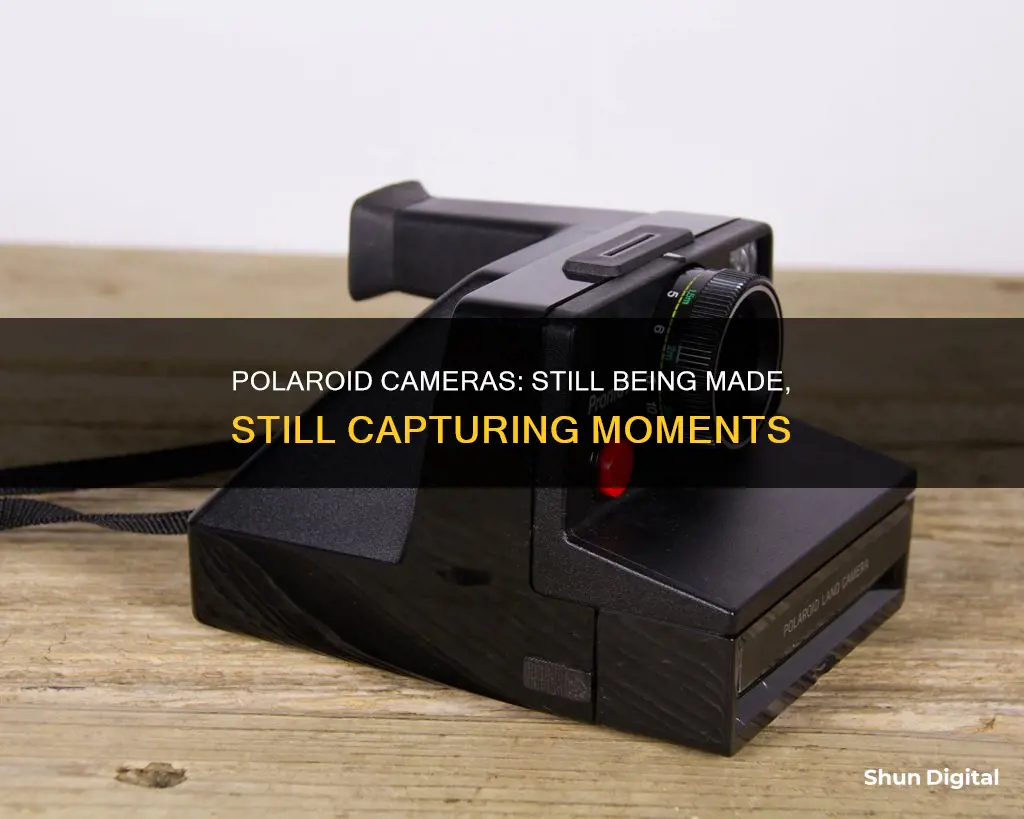
The Polaroid camera, invented by Edwin Herbert Land, was once the most popular camera in the world. It was easy to use and provided instant prints, no darkroom development needed. However, the rise of digital photography and smartphones with built-in cameras caused a decline in Polaroid's sales. Despite this, Polaroid cameras have made a comeback in recent years, with new models offering digital features and instant prints. The vintage versions of these cameras are also gaining value, with some selling for thousands of dollars.
| Characteristics | Values |
|---|---|
| Company | Polaroid Corporation |
| Founder | Edwin H. Land |
| Founded | 1937 |
| Headquarters | Cambridge, Massachusetts |
| Initial Market | Polarized Sunglasses |
| First Instant Camera | The Land Camera, 1948 |
| Peak Employment | 21,000 in 1978 |
| Peak Revenue | $3 billion in 1991 |
| Current Status | Still in business |
What You'll Learn
- The Polaroid Corporation was founded in 1937 by Edwin H. Land
- The first instant camera, the Land Camera, was created by Land in 1948
- The Polaroid camera was most popular in the 1970s and 1980s
- The company was declared bankrupt in 2001
- Polaroid cameras are trending again, alongside other retro items like vinyl records

The Polaroid Corporation was founded in 1937 by Edwin H. Land
Land's interest in light and colour began while he was a student at Harvard University. He became intrigued by polarized light and, after taking a leave of absence, successfully aligned submicroscopic crystals of iodoquinine sulfate and embedded them in a sheet of plastic. This polarizer, dubbed the Polaroid J sheet, was a significant advancement as it allowed for larger polarizer sizes and reduced costs.
In 1932, Land and Wheelwright founded the Land-Wheelwright Laboratories in Boston to further develop and commercialize polarizing technology. By 1936, Land was using Polaroid material in sunglasses and other optical devices, and in 1937, the company was renamed the Polaroid Corporation.
Land's initial focus was on polarized sunglasses, which were spawned from his self-guided research in light polarization. However, he soon expanded the use of his polarizing polymer to other products, including 3D movies and protective goggles for military dogs. During World War II, Polaroid also designed and manufactured various products for the armed services, such as an infrared night viewing device.
In 1948, Land and Polaroid created the first instant camera, the Land Camera, which went on sale in late 1948. This camera revolutionised photography by allowing a picture to be taken and developed in 60 seconds or less. The Land Camera was an instant success, with all 57 units of the first batch selling out on the first day of demonstrations.
Land led the Polaroid Corporation as CEO for 43 years, guiding it from a small research and marketing firm to a well-known high-tech company. He was recognised as the father of instant photography, as he included all the operations of a darkroom inside the film itself.
In addition to his work with Polaroid, Land contributed to various military projects during the early years of the Cold War, including the development of photographic reconnaissance and intelligence-gathering technologies. He also played a role in designing the optics of the Lockheed U-2 spy plane.
Land received numerous honours and awards for his innovations, including over 500 patents. He died in 1991, leaving behind a legacy of scientific advancements and a company that continues to bear his name.
DRO Camera Mode: What's the Deal?
You may want to see also

The first instant camera, the Land Camera, was created by Land in 1948
The first instant camera, the Land Camera, was created by Edwin Herbert Land in 1948. The camera was the result of several years of work by Land, who was inspired to create a system of instant photography after his daughter asked him why she couldn't see a photo he had just taken of her. Land's system was a radical departure from traditional film processing, requiring a new type of camera and film that would compress all the components of a darkroom into a single film unit.
The first commercial instant camera was called the Model 95, and it went on sale in 1948 at a department store in Boston. The Model 95 produced sepia-toned images and took about a minute to develop. The cameras were incredibly popular and sold out in minutes. The Model 95 was followed by a true black-and-white version in 1950, and over the next decade, Polaroid released a series of innovations that improved picture quality. By 1957, the New York Times called instant photography "equal in tonal range and brilliance to some of the finest prints made by the usual darkroom routine".
The Land Camera was a self-developing film camera manufactured by Polaroid between 1948 and 1983. It was named after its inventor, American scientist Edwin Land, who developed the process for self-developing photography between 1943 and 1947. The camera employed diffusion transfer to move the dyes from the negative to the positive via a reagent, creating a developing film "sandwich". After a minute, the back of the camera was opened, and the negative was peeled away to reveal the print.
The invention of the Land Camera revolutionised the photography industry, allowing users to evaluate and share images moments after they were taken. This transformational change from traditional photography made the Land Camera incredibly popular, and it has since become an iconic piece of technology.
Third-Party Batteries: Safe Power for Your Camera?
You may want to see also

The Polaroid camera was most popular in the 1970s and 1980s
The 1970s saw Polaroid at the forefront of innovation, with the company constantly refining its instant camera technology. During this time, Polaroid also faced a significant legal challenge from Kodak, which had announced the release of instant-photo cameras in 1976. Polaroid sued Kodak, accusing them of stealing their patented instant photography process. The lawsuit lasted ten years, with the court ultimately ruling in Polaroid's favour and ordering Kodak to pay $909.5 million in damages.
The 1980s, however, brought new challenges for Polaroid. The company struggled to adapt to the rapidly evolving world of photography, with the introduction of new technologies such as one-hour colour film processing, single-use cameras, videotape camcorders, and the emergence of digital cameras. Polaroid attempted to diversify its product line, shifting away from a dependence on consumer photography, but these efforts had limited success. The company's revenue peaked at $3 billion in 1991, but by the mid-1990s, Polaroid camera sales began to decline as consumers opted for more affordable disposable cameras and digital photography.
Despite these challenges, Polaroid remains a recognisable brand, and its instant cameras continue to hold a nostalgic appeal for many. The company has survived through various acquisitions and rebranding efforts, and instant photography still has a dedicated fan base.
Aslain's Free Camera Mod: Unleashing Dynamic Perspectives
You may want to see also

The company was declared bankrupt in 2001
The Polaroid Corporation was declared bankrupt in 2001, but that wasn't the end of the company or its products. The brand and assets were sold off, and a new Polaroid company was formed. The new company changed hands several times before being purchased by Polish billionaire Wiaczesław Smołokowski in 2017.
The bankruptcy of the original Polaroid Corporation was largely due to the failure of senior management to anticipate the impact of digital cameras on its film business. This type of managerial failure is known as the success trap. Despite the bankruptcy, Polaroid-branded products continued to be developed and released by various licensees globally, including LCD televisions and DVD players.
Prior to the bankruptcy, the original Polaroid Corporation sold its historic headquarters building and property for $10 million. The company filed for federal Chapter 11 bankruptcy protection on October 11, 2001. Within ten months, most of the business, including the "Polaroid" name, had been sold to Bank One's One Equity Partners (OEP). This new company operated under the name Polaroid Corporation, even though it was legally called the OEP Imaging Corporation and later the Polaroid Holding Company (PHC).
The "takeover" by OEP was controversial because it left executives with large bonuses, while stockholders and employees were left with nothing. The new company gave bonuses to the top 45 executives for staying in their jobs, while other employees were restricted from selling their stock before leaving. As part of the settlement, the original Polaroid Corporation changed its name to Primary PDC, Inc. and received approximately 35 percent of the new Polaroid, which was distributed to unsecured creditors.
The Polaroid brand survived the bankruptcy and was licensed for use on other products. In 2002, World Wide Licenses was granted exclusive rights to manufacture and sell digital cameras under the Polaroid brand for three years. Polaroid-branded LCDs, plasma televisions, and portable DVD players also appeared on the market. In 2005, the Petters Group Worldwide acquired PHC, and in 2007, Polaroid stopped making cameras and discontinued the sale of film after 2009.
Despite the bankruptcy and changes in ownership, the Polaroid brand and its products have persisted and even experienced a resurgence in popularity. The new Polaroid company formed after the bankruptcy has continued to release instant cameras and films, with modern features and improvements.
GoPro Cameras: Made in the USA?
You may want to see also

Polaroid cameras are trending again, alongside other retro items like vinyl records
Despite this, Polaroid cameras are experiencing a resurgence in popularity. One reason for this revival is nostalgia, as individuals seek to reconnect with the tangible nature of physical photographs. Young people, including those who weren't around during the golden age of Polaroid, are drawn to the unique appeal of holding a photo in their hands and having a keepsake. The tactile and physical nature of Polaroid photos provides a meaningful sense of tactility and a stylish link to the past. Additionally, the new generations of Polaroid cameras have incorporated digital features, such as capturing digital images alongside instant prints, improved design, higher resolution, better colour accuracy, and creative features like multiple exposure modes and built-in filters.
Similarly, vinyl records are also undergoing a revival, with renewed interest and increased sales globally. This trend can be attributed to a combination of factors, including the romanticism and ritual of listening to records, the higher-quality sound, and the appeal of owning physical music in an increasingly digital world. The vinyl revival is driven primarily by younger consumers, particularly millennials, who appreciate the experience of listening to an entire album from start to finish and the ability to engage with the music in a more meaningful way.
The resurgence of Polaroid cameras and vinyl records highlights a broader trend of retro items making a comeback. In a world where technology and digital media dominate, there is a growing appreciation for the analogue and physical nature of older technologies. The tactile and nostalgic qualities of these retro items offer a unique experience that resonates with individuals seeking a connection to the past and a break from the fast-paced nature of modern life.
Charging Camera Battery Packs: A Step-by-Step Guide
You may want to see also
Frequently asked questions
Yes, Polaroid cameras are still made and they are gaining popularity once again.
Some Polaroid camera models that are currently available include the Polaroid Now Generation 2 i-Type Instant Camera, Polaroid Go Generation 2 Instant Camera, and the Polaroid I-2 Instant Camera.
Modern Polaroid cameras often allow users to capture digital images alongside instant prints, have a more compact design, offer higher resolution, better colour accuracy for sharper and more vibrant instant prints, and creative features such as multiple exposure modes, self-timers, and built-in filters.
On eBay, many vintage Polaroids have asking prices over $1,000, with prices topping out at nearly $7,000.







